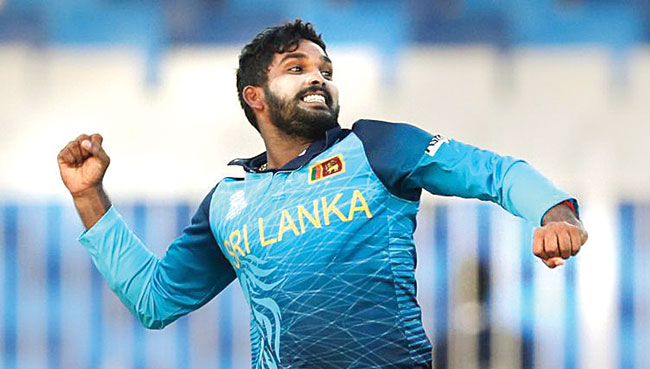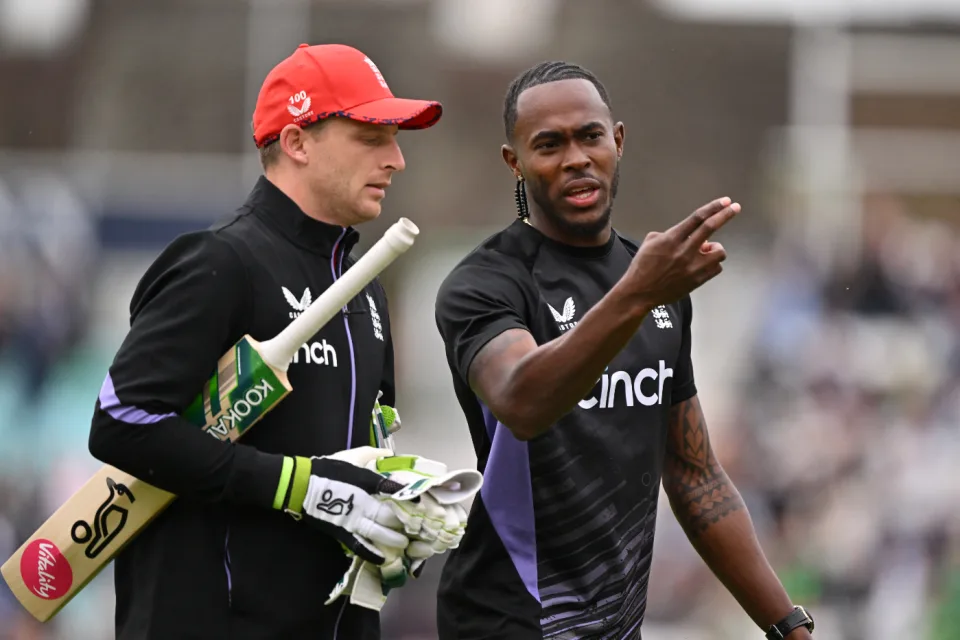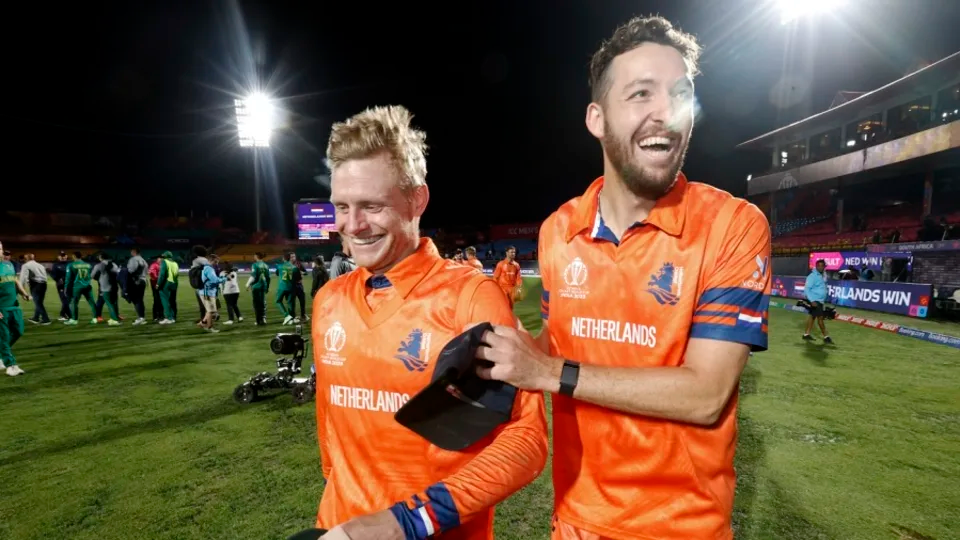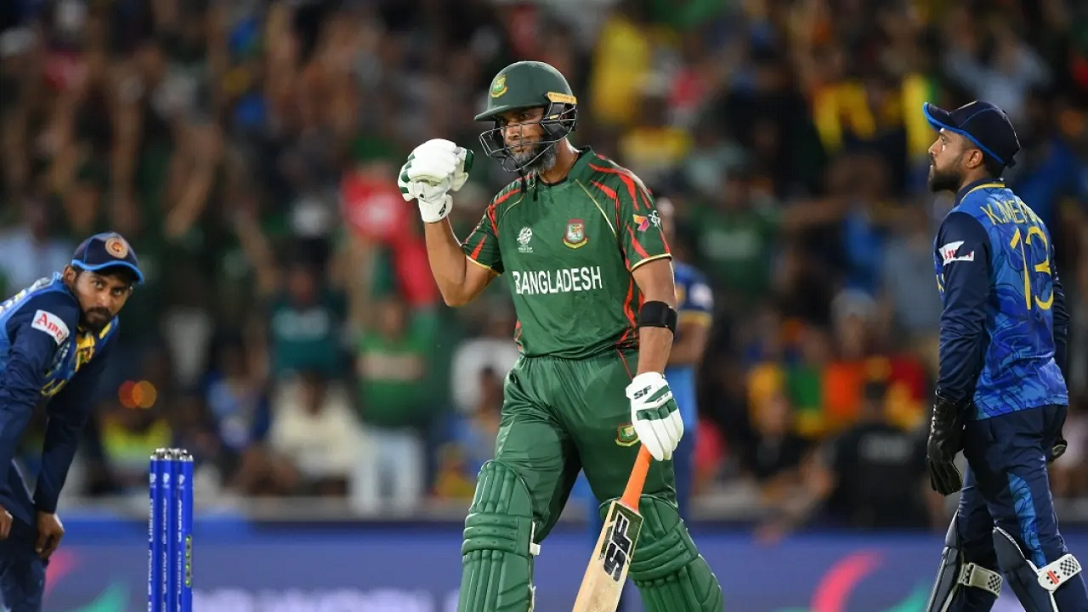Sports
Wanidu Hasaranga among nominees for ICC Men’s T20I Player of the Year

Wanidu Hasaranga, Mohamed Rizwan, Mitchelle Marsh, and Jos Buttler are the nominees for the 2021 ICC Men’s T20I Player of the Year awards.
Here, we take a look at the memorable performances of the two brilliant wicket keepers and two all-rounders.
Mohammad Rizwan – Pakistan
1326 runs in 29 matches at an average of 73.66 with one century; 24 dismissals.
The Pakistan wicketkeeper-batter ruled the roost in 2021 when it came to the shortest format of the game. Aggregating a staggering 1326 runs in only 29 matches, Rizwan struck at an average of 73.66 and a strike-rate of 134.89. Apart from his exploits with the bat, he was as solid as ever behind the stumps, playing a key role in Pakistan’s run to the semis during the ICC Men’s T20 World Cup 2021, where he ended up as the third-highest run-scorer.
He also scored the maiden T20I century of his career against South Africa in Lahore early in the year and ended it continuing his form with a brilliant knock of 87 against West Indies in Karachi. With another T20 World Cup coming up next year, Pakistan will hope that Rizwan continues in the same vein.
Though a chase of 152 looked easy on paper, Pakistan had the weight of history against them in the T20 World Cup encounter against India. With the likes of Jasprit Bumrah and Mohammad Shami in opposition attack, the task was made all the more complicated. But as was almost always the case in 2021, Rizwan along with his skipper Babar Azam ensured that a famous victory would be sealed that would be celebrated in the history of Pakistan cricket for years to come.
Rizwan smacked 79* in only 55 deliveries, hitting six fours and three sixes. The ease with which he countered the Indian bowling attack was a thing of sheer beauty. He ensured that there were no hiccups in the run-chase as Pakistan galloped towards the target without losing a single wicket to seal a 10-wicket victory.
Wanindu Hasaranga – Sri Lanka
36 wickets in 20 matches at 11.63; 196 runs with one half-century
It was a breakthrough year for Wanindu Hasaranga, who established himself as one of the best spinners in the shortest format while also being a player who could contribute with the bat. A consistent performer throughout the year, Hasaranga’s star shone the brightest during the T20 World Cup in UAE and Oman.
He ended the tournament as the leading wicket-taker with 16 scalps and also played some handy knocks with the bat, like his 71 against Ireland. He was a constant menace for the opposition as Sri Lanka impressed one and all during the tournament with their young and energetic side.
Still only 24, Hasaranga is expected to become a cornerstone of Sri Lankan cricket, especially in the shortest formats of the game.
In a pressure encounter in Sharjah against South Africa, Hasaranga almost single-handedly helped his side claw back into the contest with his brilliance with the ball. Claiming a memorable hat-trick, he took the big scalps of Aiden Markram (19) and Temba Bavuma (46) before dismissing Dwaine Pretorius to complete his hat-trick.
Hasaranga would end up with figures of 3/20 in his four-over spell, and it was only the power-hitting of David Miller at the death that got the Proteas over the line.
Mitchell Marsh – Australia
627 runs in 27 matches at 36.88; 8 wickets at 18.37.
The year that was
Australia’s success at the T20 World Cup can be traced back to the decision to move Mitchell Marsh up the batting order to No.3, instead of designating him the role of being a finisher lower down. Throughout the calendar year, he was their best batter in the shortest format, improving his game by leaps and bounds, especially against spin and when it came to rotating the strike.
He was the silver lining in Australia’s poor showings in West Indies and Bangladesh batting higher up the order. Heading into the tournament in UAE and Oman, he was in supreme confidence after his good displays and improved fitness. This led to a fruitful tournament as he aggregated 185 runs in 6 matches at an average of 61.66 and a healthy strike-rate of 146.82. He would reserve the best for the last, playing a match-winning knock in the final against New Zealand.
Chasing down a target of 173 and after the early departure of skipper Aaron Finch, the pressure was on Marsh to build a substantial partnership with David Warner. He did exactly that, playing his best knock of the tournament. His unbeaten 77 off 50 deliveries consisted of six fours and four sixes.
Starting off aggressively, he rotated the strike brilliantly in the middle overs as he teed off again towards the end. His knock ensured that Australia chased down the challenging target in only 18.5 overs, and were crowned the winners of the T20 World Cup for the first time. For his performance, he was adjudged the Player of the Match.
Jos Buttler – England
589 runs in 14 matches at 65.44 with one century; 13 dismissals
The year gone by
Buttler started the year off brilliantly with two blistering knocks against India away from home. He would continue this run in the subsequent series against Sri Lanka and Pakistan, despite not playing all the matches. This boded well for England as their key batter was in sublime touch heading into the T20 World Cup.
He did not disappoint in the tournament, always getting his side off to brilliant starts. His two best knocks came in consecutive matches – first against age-old rivals Australia and then against Sri Lanka who faced his full wrath.
He ended the tournament as England’s leading run-scorer with 269 runs, as their run would be ended by New Zealand in the semi-finals in a nail-biting thriller.
Blasting the first century of the tournament, Buttler was at his belligerent best in the encounter against Sri Lanka in Sharjah. It was ball-striking of the highest order as the wicketkeeper-batter penetrated all areas of the ground.
His unbeaten 101 came in only 67 deliveries and consisted of six fours and six sixes. Buttler’s knock allowed England to post a competitive score of 163/4, which they ended up defending and winning the contest by 26 runs.
The value of his knock was accentuated as it came on a slow and low pitch in Sharjah, which wasn’t conducive to a stroke-maker like Buttler, with the batters finding it generally tough to time the ball.
(ICC)
Sports
England face Australia in the battle of champions

The first truly heavyweight clash of this expanded T20 World Cup format comes freighted with both history and subplots. A rematch of the 2010 World T20 final at Kensington Oval, the match pits Jos Buttler’s defending champions – who are aiming to become the first team to retain the trophy – against the Australian winning machine, victors at the 2021 edition and current world title-holders in Test and ODI cricket. And that’s before you throw in the Ashes for afters.
Already there is added pressure on England, after the rain in Bridgetown led to a share of the points in their opener against Scotland (and that having conceded 90 runs from 10 overs without taking a wicket in a tepid bowling display). Lose to their oldest rivals and it will leave their Super 8 prospects open to being waylaid by the perils of net run-rate calculations, or worse.
The Scotland match was the third abandonment in five suffered by England, after a rain-affected home series against Pakistan, which has clearly hampered their readiness for this campaign after almost six months without playing T20 together. It does not take much for a side to click in this format – and England looked in decent shape when they did get on the field against Pakistan – but Buttler will be anxious for things to go their way on Saturday, if only to avoid further questions referencing the team’s disastrous ODI World Cup defence last year.
Australia, under the laidback leadership of Mitchell Marsh would love nothing more than to add to the English sense of jeopardy – having helped bundle them out of the tournament in India on the way to taking the crown. Their head to head record is less impressive in T20 however, with England having won six of the last seven completed encounters, as well as that 2010 final.
Despite a wobble with the bat, Australia avoided mishap against Oman earlier in the week, the experience of David Warner and Marcus Stoinis shining through in difficult batting conditions. Surfaces in the Caribbean – not to mention those games staged in the USA – have already had teams scratching their heads; rather than the “slug-fest” England had prepared for, following a high-scoring tour of the Caribbean in December, it looks as if boxing smart may be the way to go.
Speaking of Warner, this could be the last time he faces up against England in national colours – and another match-winning contribution would likely reduce the chances of them meeting again in the knockouts. On the other side of the card is Jofra Archer, fresh from an emotional maiden outing at Kensington Oval and ready to take on Australia for the first time in any format since 2020. Can Mark Wood fire up England’s campaign, as he did during last summer’s Ashes? Will Pat Cummins be back to harass the old enemy once again? Seconds out, it’s almost time to rumble.
Cummins is set to return after being rested for the Oman game, which saw Mitchell Starc leave the field with cramp. Starc is understood to be fine and could keep his place – which would likely see Nathan Ellis miss out. Marsh is still not fit to bowl, with Australia likely to continue with the allrounder combination of Stoinis and Maxwell to give them cover.
Australia (probable XI): David Warner, Travis Head, Mitchell Marsh (capt), Glenn Maxwell, Marcus Stoinis, Josh Inglis (wk), Tim David, Pat Cummins, Nathan Ellis/Mitchell Starc, Adam Zampa, Josh Hazlewood
The one change England may consider is Reece Topley coming in for Wood, with the expectation that there will be some rotation among the seamers through the course of the tournament.
England (probable XI): Phil Salt, Jos Buttler (capt & wk), Will Jacks, Jonny Bairstow, Harry Brook, Liam Livingstone, Moeen Ali, Chris Jordan, Jofra Archer, Adil Rashid, Reece Topley/Mark Wood
[Cricinfo]
Sports
South Africa up against their bogey team in batter-unfriendly New York

Once is coincidence, twice is a clue, and three times is proof.
To paraphrase Agatha Christie, that is the narrative around South Africa’s meeting with Netherlands at this T20 World Cup.
The Dutch beat South Africa at the 2022 tournament and ended their semi-final hopes in a match where South Africa appeared to be sleep walking, and then beat them again at the 2023 ODI World Cup, where they exposed South Africa’s vulnerability in the chase. If they to do the treble, not only will Netherlands take the lead in Group D, but they will offer conclusive evidence of the threat they pose to Full Members, especially South Africa.
Of course, it will take some doing after South Africa’s opening performance against Sri Lanka, where they reduced their opposition to their lowest T20I total and chased it down in fairly straightforward fashion thanks to the most stable middle-order of their white-ball era. In Aiden Markram, Tristan Stubbs, Heinrich Klaasen and David Miller, South Africa have bankers and big-hitters and, for this match, they also have the advantage of experience. They’ve already played at Eisenhower Park, and have first-hand knowledge that run-scoring doesn’t come easily;Klassen said they are prepared to use their “cricket brains” and play “smarter cricket”.
But the conditions could be good news for Netherlands, who are not naturally a line-up of big hitters and build their innings on a foundation of turning ones into twos. In other words, they tend to take a slightly more conservative approach to batting, which may work well here, but they’ll be wary of the uneven bounce of the surface and will have to come up with plans to counterattack especially against South Africa’s seamers. Their own bowlers were exemplary in Dallas and will look to build on that performance against a line-up that will likely be more proactive than Nepal’s, but who they have managed to keep quiet not once, but twice in the past. Third time’s the charm, they say.
Anrich Nortje’s stunning return to form against Sri Lanka means South Africa may not have to tinker with the bowling combination, and Gerald Coetzee and Tabraiz Shamsi may have to wait their turns to get a game. The batting line-up should be unchanged, with no space for Ryan Rickelton yet.
South Africa: Quinton de Kock (wk), Reeza Hendricks, Aiden Markam, Tristan Stubbs, Heinrich Klaasen (wk), David Miller, Marco Jansen, Keshav Maharaj, Kagiso Rabada, Ottneil Baartman, Anrich Nortje
Conditions in New York may tempt Netherlands to include an extra seamer and they have Kyle Klein in their squad. But it could come at the expense of a shortened batting line-up and they may not want to risk that.
Netherlands: Michael Levitt, Max O’Dowd, Vikramjit Singh, Sybrand Engelbrecht, Scott Edwards (capt, wk), Bas de Leede, Teja Nidamanuru, Logan van Beek, Tim Pringle, Paul van Meekeren, Vivian Kingma
[Cricinfo]
Latest News
Mustafizur, Rishad, Hridoy dazzle in Bangladesh’s tight two-wicket win over Sri Lanka

Nuwan Thushara’s last over brought Sri Lanka screaming back into the match,as he first bowled Rishad Hossain, and then nailed Taskin Ahmed in front of the stumps with a pinpoint swinging yorker. This left Bangladesh eight wickets down, with 12 runs still to get.
However, the experienced Mahmudullah was at the crease for Bangladesh, and despite some further nervy moments, pushed Bangladesh across the line off the last ball of the 19th over.
But this was a match chiefly decided by Bangladesh’s own outstanding bowling. Mustafizur Rahman was the best among them, using shorter lengths and his cutters efficiently, to claim figures of 3 for 17. Rishad Hossain’s three-for through the middle overs also kept Sri Lanka quiet.
Mustafizur was instrumental in Sri Lanka’s downward spiral through the middle overs, which culminated in a crash-and-burn end. Ultimately, their inability to find boundaries, or even rotate strike against good Bangladesh bowling resulted in their downfall. A score of 125 for 9 always seemed poor on a decent pitch, even if their bowlers made a match of it in the end.
Brief scores:
Bangladesh 125 for 8 in 19 overs (Towhid Hridoy 40, Litton Das 36; Dhanajaya de Silva 1-11, Nuwan Thushara 4-18, Wanidu Hasaranga 2-32, Matheesha Pathirana 1-27) beat Sri Lanka124 for 9 in 20 overs (Pathum Nissanka 47, Dhananjaya de Silva 21; Tanzim Hasan Sakib 1-24, Taskin Ahmed 2-25, Mustafizur Rahman 3-17, Rishad Hossain 3-22) by two wickets
[Cricinfo]





















